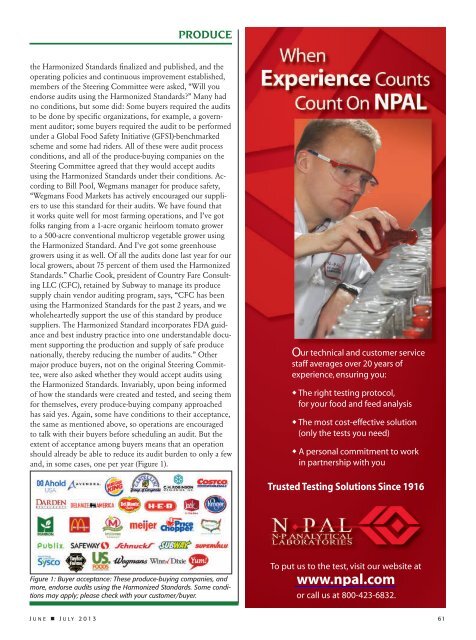Food Safety Magazine - June/July 2013
Food Safety Magazine - June/July 2013
Food Safety Magazine - June/July 2013
Create successful ePaper yourself
Turn your PDF publications into a flip-book with our unique Google optimized e-Paper software.
PRODUCE<br />
the Harmonized Standards finalized and published, and the<br />
operating policies and continuous improvement established,<br />
members of the Steering Committee were asked, “Will you<br />
endorse audits using the Harmonized Standards?” Many had<br />
no conditions, but some did: Some buyers required the audits<br />
to be done by specific organizations, for example, a government<br />
auditor; some buyers required the audit to be performed<br />
under a Global <strong>Food</strong> <strong>Safety</strong> Initiative (GFSI)-benchmarked<br />
scheme and some had riders. All of these were audit process<br />
conditions, and all of the produce-buying companies on the<br />
Steering Committee agreed that they would accept audits<br />
using the Harmonized Standards under their conditions. According<br />
to Bill Pool, Wegmans manager for produce safety,<br />
“Wegmans <strong>Food</strong> Markets has actively encouraged our suppliers<br />
to use this standard for their audits. We have found that<br />
it works quite well for most farming operations, and I’ve got<br />
folks ranging from a 1-acre organic heirloom tomato grower<br />
to a 500-acre conventional multicrop vegetable grower using<br />
the Harmonized Standard. And I’ve got some greenhouse<br />
growers using it as well. Of all the audits done last year for our<br />
local growers, about 75 percent of them used the Harmonized<br />
Standards.” Charlie Cook, president of Country Fare Consulting<br />
LLC (CFC), retained by Subway to manage its produce<br />
supply chain vendor auditing program, says, “CFC has been<br />
using the Harmonized Standards for the past 2 years, and we<br />
wholeheartedly support the use of this standard by produce<br />
suppliers. The Harmonized Standard incorporates FDA guidance<br />
and best industry practice into one understandable document<br />
supporting the production and supply of safe produce<br />
nationally, thereby reducing the number of audits.” Other<br />
major produce buyers, not on the original Steering Committee,<br />
were also asked whether they would accept audits using<br />
the Harmonized Standards. Invariably, upon being informed<br />
of how the standards were created and tested, and seeing them<br />
for themselves, every produce-buying company approached<br />
has said yes. Again, some have conditions to their acceptance,<br />
the same as mentioned above, so operations are encouraged<br />
to talk with their buyers before scheduling an audit. But the<br />
extent of acceptance among buyers means that an operation<br />
should already be able to reduce its audit burden to only a few<br />
and, in some cases, one per year (Figure 1).<br />
Our technical and customer service<br />
staff averages over 20 years of<br />
experience, ensuring you:<br />
The right testing protocol,<br />
for your food and feed analysis<br />
The most cost-effective solution<br />
(only the tests you need)<br />
A personal commitment to work<br />
in partnership with you<br />
Trusted Testing Solutions Since 1916<br />
Figure 1: Buyer acceptance: These produce-buying companies, and<br />
more, endorse audits using the Harmonized Standards. Some conditions<br />
may apply; please check with your customer/buyer.<br />
To put us to the test, visit our website at<br />
www.npal.com<br />
or call us at 800-423-6832.<br />
J u n e • J u l y 2 0 1 3 61






![Otomatik indirilmez ise tıklayınız [Download]](https://img.yumpu.com/44170525/1/190x190/otomatik-indirilmez-ise-taklayanaz-download.jpg?quality=85)










